In response to the lockdown triggered by COVID-19, many arts organisations have taken their work online, sharing content for audiences to view for free. However, creating participatory engagement online is much more challenging and, as a sector used to being face to face with people in their practice, it’s clear that the current restrictions change the nature of participatory arts based activity substantially.
Following a vital conversation on social media led by Guy O’Donnell, Learning and Participation Producer, National Dance Company Wales which opened a discussion on how we can deliver participatory arts effectively, a range of partners are collaborating to lead Zoom discussions for the sector where we can talk about the impact of the lockdown on our work and work creatively together to think beyond the lockdown.
In partnership with ArtWorks Cymru a series of free Zoom meetings have been set up to discuss and share current working practices in participatory delivery.
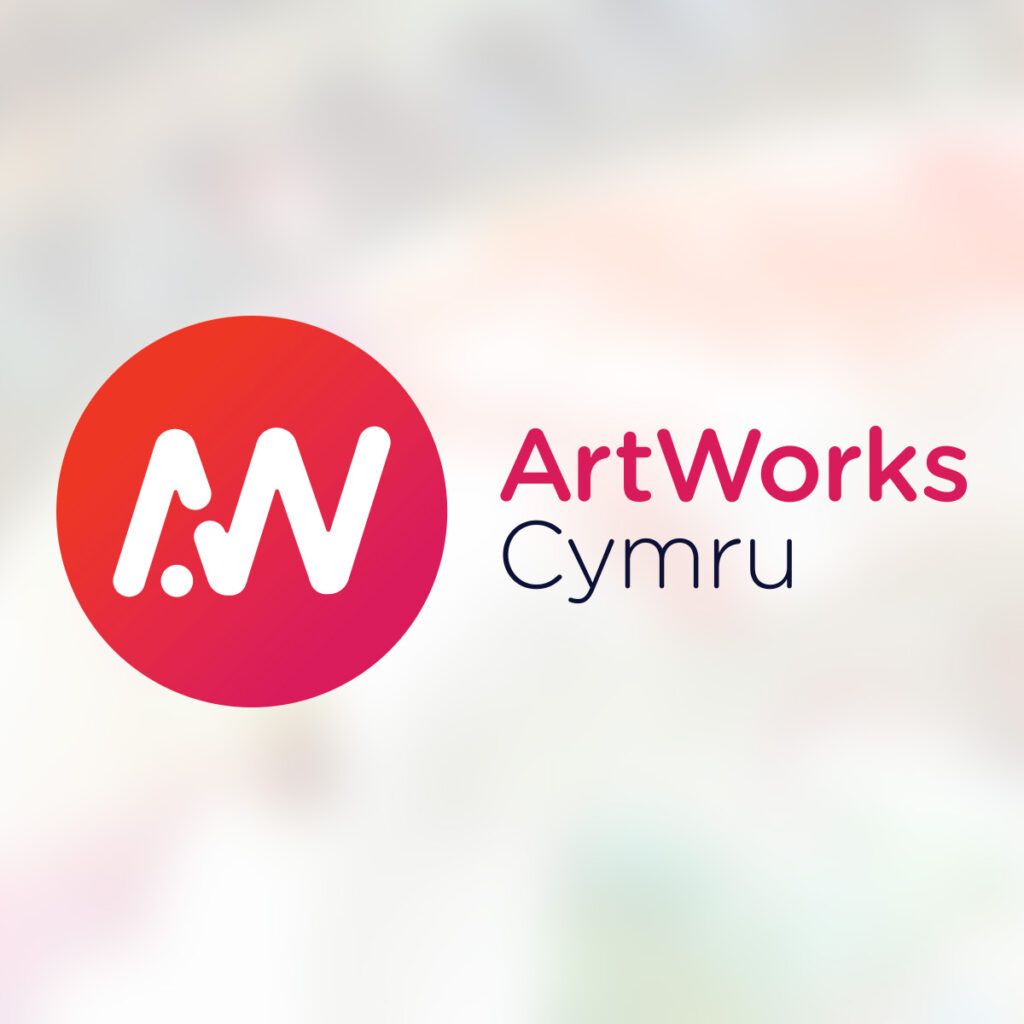
Capturing the Learning
These Zoom meetings will explore how we capture the learning from organisations and artists who are currently delivering projects. We’ll explore what methods are working well, what are we learning through this experience, and how we are adapting our working practices.
Megan Pritchard, Marketing Campaigns, National Dance Company Wales is presenting at the first Zoom Dance meeting on Wednesday 3rd June 3-5pm The meetings are free to attend but numbers are limited. Megan gives an overview of the work NDCWales has created to meet the challenges and the companies solutions to support professional and participatory dance delivery in the current climate.

Hi can you tell me a little about yourself and your practice?
Hi I’m the Marketing Campaigns Manager for National Dance Company Wales: under usual circumstances that means I lead on connecting with our audiences and communities with a focus on the national touring work that we do. I work closely with the Participation department who are a fundamental part of how we connect with and stay connected with our audiences.
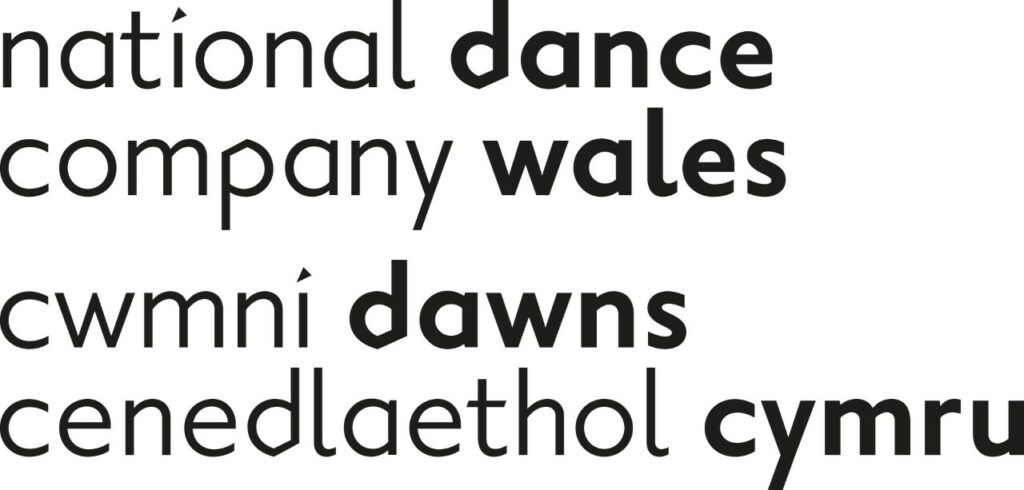
At the moment that work is much the same – but with a hugely digital focus, and a wealth of new ways to share dance with people. From early on in the lockdown we’ve seen a huge rise in people dancing across media from TicTok to daily community dance parties in the street.
I’ve been with the Company for just under nine years so for me that’s really exciting to see, the heart of my role is sharing this thing that I love with the world- I truly believe that dance is a universal language that is available for everyone from shuffling along to the radio in your kitchen right through to sitting in an Opera House watching a contemporary ballet.
NDCWales has as real ethos that dance is a wide spectrum and we try touch people with dance at all levels. I’m here to reassure those unsure about watching dance or bringing physicality into their bodies – to take away that fear of the unknown.
What challenges did lockdown present to delivery of your participatory practice and what systems did you put in place to ensure delivery?
Our biggest challenge was not unique – how could we digitally re-create work that relies on physicality and connection; how could we do it with reduced resource, and what should the focus be?
We were just two venues into our twelve venue mid-scale touring – our largest annual tour, one that we rely on not just for income but for connecting with people.
As a Company we already had plans to create a digital programme over the next year, but in response to COVID 19 we needed to do this more urgently. We were not in a position to move everything that we usually do online, there wasn’t the money or capacity – but as a Company we value all aspects of our work equally. To help focus our resources, we asked our audiences and looked inwards,
“National Dance Company Wales makes brilliant dance with and for all kinds of people in all kinds of places. With innovation and imagination, we widen the spectrum of what dance can be so that more people can make, watch, participate in and learn about dance in Wales and across the world.”
So we put our energy on repurposing what we already had and building on what we do well- creating spaces to learn about, and participate in dance at a range of levels.
It was important too that content was as accessible as possible – using captions and BSL interpreters wherever we could. This meant that things such as live classes were not a solution for us at the outset because they could not easily be captioned in real time.
To make things as streamlined as possible we used simple ideas and simple programmes, that could be used quickly and taught quickly to people who might be working in new ways.
We used Zoom, YouTube and Facebook live and explored new ways of manipulating these programmes in ways that they may not usually be used. We also used simple editing and captioning programmes – and taught anyone in the Company with a free hour how to use them.
To ensure a polished feel despite content being created in different spaces, on different cameras and in different styles, we created simple branding and guidelines that were easy to follow and carefully spent money on animations to tie the content together.
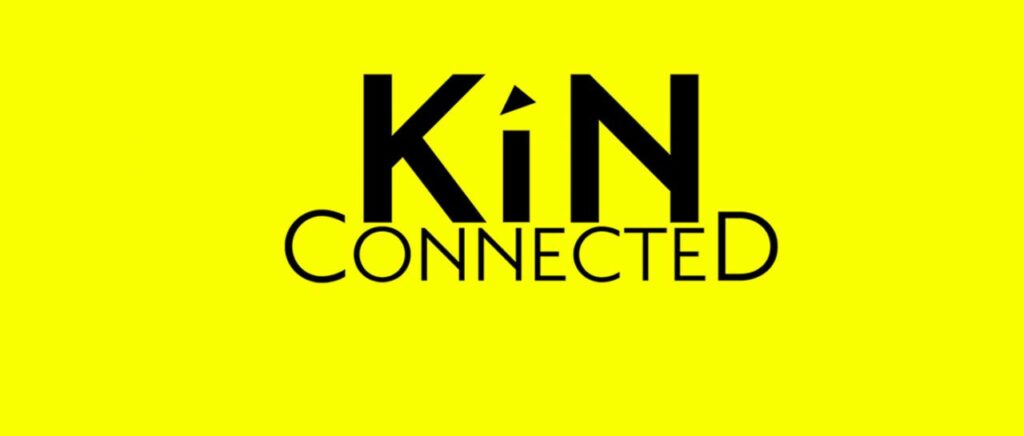
The creation of #KiN:Connected was hard work, but that hard work was met with innovative ideas and rewarding content – and I’m really proud of how quickly all of the team pulled together to create a virtual version of our work – right through from the performance streaming and post-show-talks to the . bilingual classes for children about rugby and dance.
Did you have any particular challenges or success that you would like to share?
I’m really proud of all of the work that we’ve pulled together to get done during this time – but some stand outs for me are:
The live performance of 2067: Time and Time and Time (a reimagining of a repertoire piece from our cancelled tour, performance from the dancers home and directed in real time by the choreographer).
Our Rygbi learning pack and everything that surrounds it (including bilingual classes for parents of welsh speaking children who may not speak welsh themselves, and of course the full length stream of the piece itself).
Our dance classes for adults with mobility issues – we’ve had a lot of mums of NDCWales team members use them in their daily routines, which has been really directly rewarding.
I think the biggest challenge for us moving forwards is maintaining meaningful relationships with our amazing participants and continuing to imagine new ways to bring dance to them – especially those who may not be digitally proficient.
What are your plans for future delivery?
We are just moving into the second phase of our digital delivery – taking our learning from the first phase and building on it with more real-time live performances and exciting collaborations with other Welsh companies. We’re also launching some things that took a little longer for us to perfect for our participants such as our Dance for Parkinson’s classes.
A range of organisations have worked to continue delivery of their art form during lockdown are there any that you would like to mention that you found either professionally or personally useful?
It’s been really inspiring to see how resilient the sector is as a whole and how vitally important the arts are for people’s health and wellbeing at this time (possibly more than ever). Arts companies have been at the forefront of providing accessible and free content for home-schooling, fun classes to keep us fit when we are unable to leave our homes, and beautiful digital distractions in the forms of films, play readings, dance, get togethers, streamed performances and more.
Below is a guide to streaming a live performance from NDCWales, Stage Manager, Perla Ponce. (Please note this information is in a draft format and will be updated.)

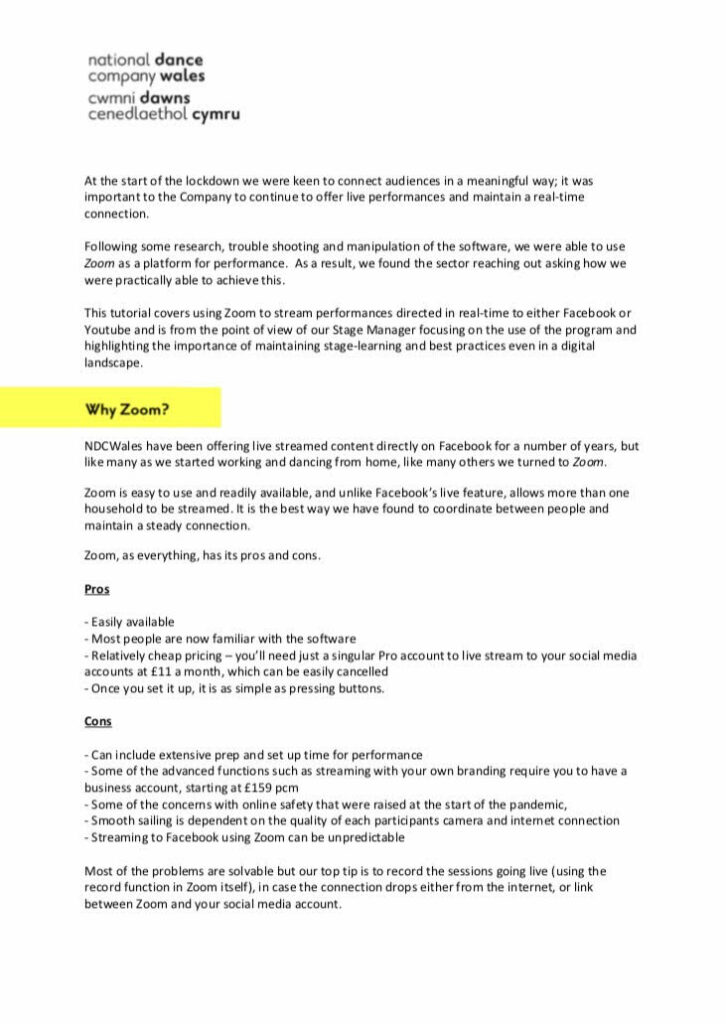
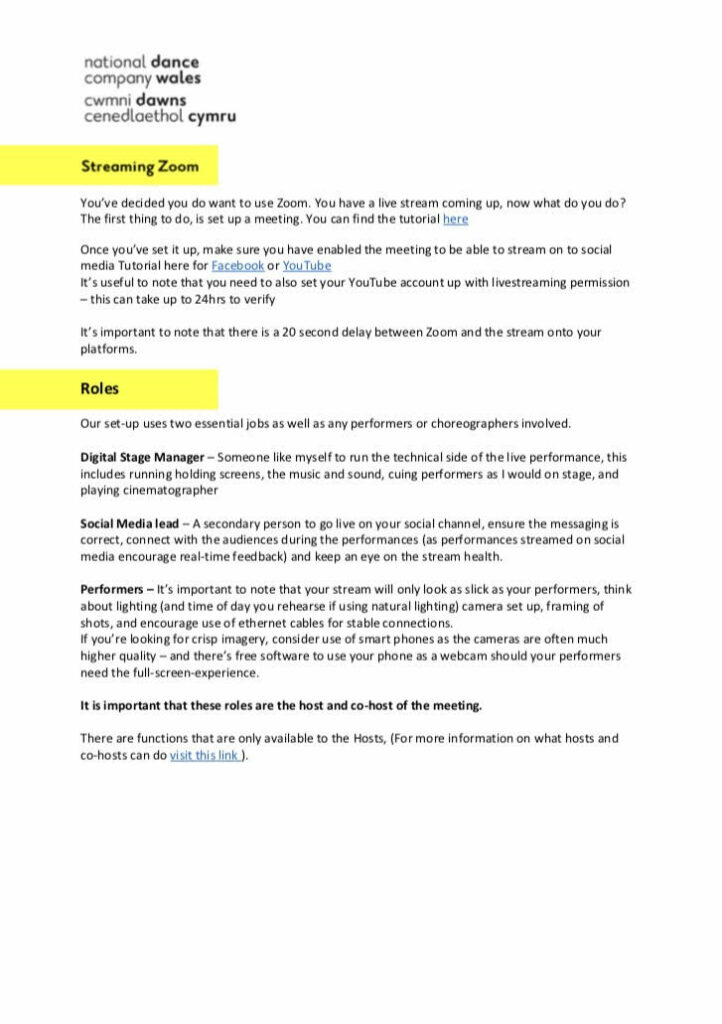

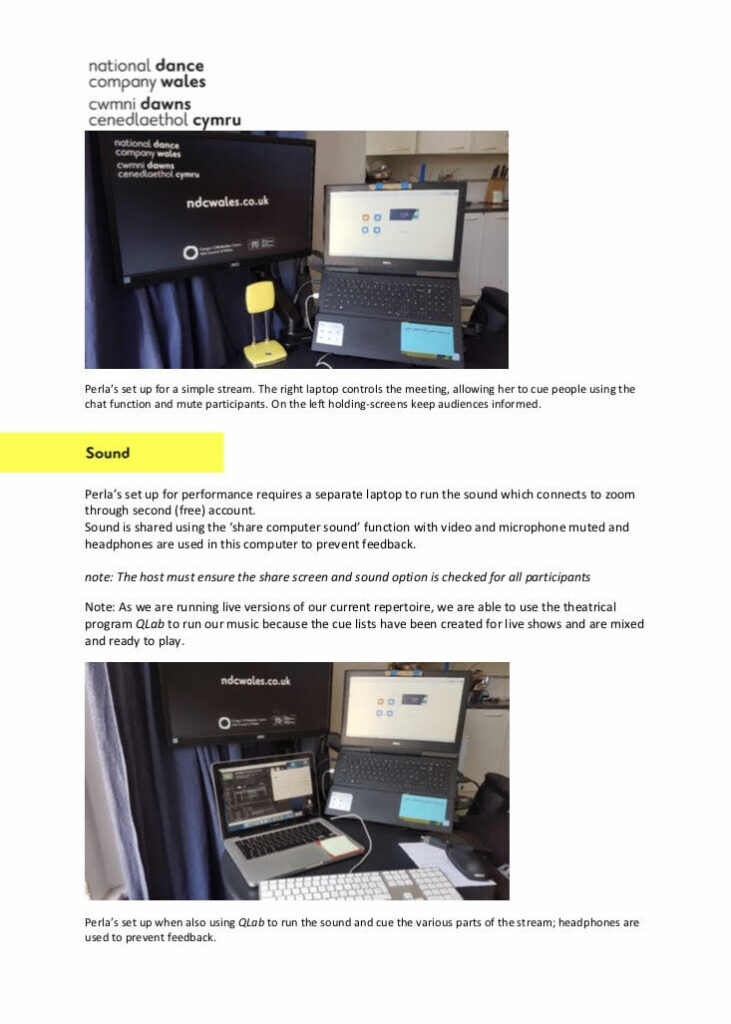



Participatory Arts, Capturing the Learning
Meeting Minutes
35 Participants
Julie Hobday – County Youth Dance Swansea
- Sister company of West Glamorgan Youth Company
- Created when Swansea became a County
- To promote dance for 13 – 21 and also run an outreach strand for younger pupils
- Collaborate across Swansea with schools, YMCA, Taliesin Arts Centre
- Creative educational model – training – exploring professional work – peer support – develop a love for the artform
- Follow an academic year
- Challenge to be flexible and keep the company relevant
- Community element is very important / but also the opportunity to create work in response to stimulus
Challenges of Lockdown
- No direct funding – all income from the students
- Meeting through Zoom. Had to put robust safe guarding in place
- Meeting participants in their homes – some participants don’t have the internet connection or capability to digitally engage.
- No shared space – we start with conversation – just so people can chat about how they are feeling and keeping everyone positive
- Keeping the dancers engaged is hard – some people are keen regulars – but some people drop off. We deal with this by emailing and prompting them through social media.
- We can’t recruit for new members at the moment.
- At the moment, we are not charging. But there are questions about how this will develop. It leaves us with a shortfall and this is vulnerable.
Positives of Lockdown
- We start by asking participants how they feel at the beginning and the end. They have usually doubled their energy by the end of the session.
- We can use artists from anywhere in the country. This has helped us to support artists who might have lost work.
- We’ve been able to engage with some of recent graduates who have missed out on their final presentations
- Being creative about how we make work – participants are making videos – they have to think differently about how to work in different spaces
- Access to resources – suddenly students can access performances and class online from some amazing companies and artists
- Trying to stay positive about the future and keep thinking about ways we can keep participants engaged through the autumn
Gwyn Emberton – BA Honours Dance University of Wales Trinity St Davids
- University course has moved on line
- Degree is based in Carmarthen.
- Intensive training in dance focused on contemporary & ballet. Also look at inclusive practice, community work.
- We hope our students will stay in Wales.
- The shutdown was very sudden – we only had a week to move everything online. We were about to start our last 2 months of big projects for the 3rd years & a final show for the 1st years. It was crucial to be face to face.
First Years
- Challenges – Bad wifi – small spaces that students were working in
- Gwyn found an online resource that he could focus the 1st years around
- They kept class regular at 10am and explored lots of different ideas
- They wanted to keep it positive and try to find things they could focus on
- Explored musicality, articulating with the upper arms, creating phrases
- 1st year is about introducing ideas and reaffirming their practice
- Ballet class – they did two phrases in one hour – took time to watch Gwyn on speaker view – and then repeat it so that Gwyn could watch them. Then they could reflect and consider.
- Used the breakouts for creative making and collaborating. It actually helped some of the less local students to open up. This was a very useful tool and gave them space and time to investigate themselves.
- Mental Health was a big thing – everyone was fluctuating. Gwyn and the students were constantly in contact with each other – used Whats App and had regular tutorials. Gwyn introduced a thursday afternoon social – a quiz or coffee and cake.
- Creating a dialogue was important – getting feedback through the screen was hard – so Gwyn would call on people and having them named was important.
- Resources online were important – students got to watch pieces that they wouldn’t usually see.
THIRD YEAR – Zosia Jo
- Worked with students to not focus on looking at her and explore disconnecting and being present in their space.
- Visualisation – Deborah Hay’s work of absorbing the space through your body.
- They made site-specific work – learnt how to make dance films together
- Each day they would make a little film – meet in the morning, work through the day and then meet in the afternoon to reflect.
- Meeting more frequently for less time works much better.
- You can only do one thing at a time online.
- Giving students as much autonomy as possible worked well. Zosia was available for questions.
Sara Sirati – Ardour Academy
- New organisation. Ten years of working in the community led to setting up a studio – mind , body and soul
- Dancer and psychotherapist – interested in trauma and how to use the body to explore it
- The dance studio also have a counselling service online – this is unusual
- We work with schools, community and the health board
- They also have a coffee shop and bar online where they do events
- Students are usually people who haven’t danced much before
- Covid struck – my first priority was the make sure all artists we worked with were OK
- Considered the options for how we might work carefully. We wanted to offer something that was good quality and really helped our dancers
Jack Philp’s experience
- Having a regular online session gave everyone a sense of stability
- I was nervous about delivering online sessions – would I be able to communicate?
- Trial and error – we navigated it together and found what worked
- Pitching the level of complexity was hard as you can’t see what people are managing and not managing
- Understanding how you can move big in a small space was a challenge
- Grappling with the tech was also difficult but Sara supported this well
- Jack found he needed to stop and check in with people regularly to see what was working and what wasn’t
Megan Pritchard – NDC Wales
- Participation is tied into touring work – decisions had to made about what needed to be taken online
- Blindsided by the sudden lockdown and were 2 venues into the tour
- We couldn’t just move everything online – lots of difficulties and barriers including Intellectual Property & rights issues
Kin Connected
- Online digital season replacing the tour
- Watch Together – some live & some pre recorded – Q&As with artists following them – they wanted to keep connection to the audiences
- Create Together – for professional artists to create something
- Dance Together – focused on dance classes for young people and for older people
- Learn Together – schools and digital work for education –
- 1. Tundra Learning Pack relating to a piece that was already online – made a you tube playlist
- 2. Created dance classes for pupils relating to our repertoire online
- 3. Rugby Learning Pack – relating to work they were already doing around rugby
- Kept things simple and accessible – so they were easy for dancers to make – and they wanted to use captions – and for them to be short, simple and available at different levels
- Created a simple brand to over arch everything.
- They had a team of people who were keen. Megan taught dancers to caption and edit. Created best practice documents to help the dancers and an intro so that the dancers all said the same thing.
- They created something for the Wales Arts Review Digithon early on and this got us thinking about how we could make work.
- Dancers are performers – we needed to make this possible somehow – so we looked at Zoom. We wanted to make it love somehow.
- Zoom can go live on You Tube – we hadn’t seen anyone using it. We played with framing and using phones. We used the spotlighting function – this was done live.The choreographer could direct the show live. The stage manager controlled the holding screens, music and spotlighting. They have created a document about how they did this which they will share with the sector.
- They have more performances planned and are thinking about how they can develop the Dance for Parkinson’s work.
- More people are dancing at home than ever – the opportunities are really exciting.
Discussion
How has online learning challenged people’s teaching skills? What strategies are people using?
- Sara – I use a feeling scale to see how people are doing. We keep our Zoom classes to smaller number so they feel more personal. We use people’s names and give people a chance to talk.
- Julie – using directive teaching methods is the default online – its harder to get feedback online. But if you know people then that’s helpful – check in moments are important. Asking questions is important so that people engage. Trying to have prolonged moments when they are doing things – but then stopping and talking – and working to get that back again. The pace is more like a rollercoaster.
- Mirroring is tricky – the camera flips round on some computers. So either you have to negotiate this or not worry about it.
- Explore Stop Gaps access training – they use great language for describing movement and this works really well on zoom
Has anyone considered creating dance exchanges with groups that wouldn’t normally get the meet?
- NYDW are involved in UDance – there will be ways to get involved.
- We can team up more as a sector. Zoom helps us to do this much better.
- Youth Dance night for NDC Wales – they are exploring how to do this online. We can co-create work with young people across the sector.
Music and licensing – questions around how to negotiate this? How have people managed this?
- NDC Wales have done lots of work on this. To use music you need written permission from the artist and the publisher. Online streaming is not covered by PRS.
- It’s a difficult area – there is music online that has been shared through Creative Commons and they are clear what tracks can be used for
- You can also get young people to compose their own music
- Or work with existing composers so it’s clear what the contractual arrangement is






